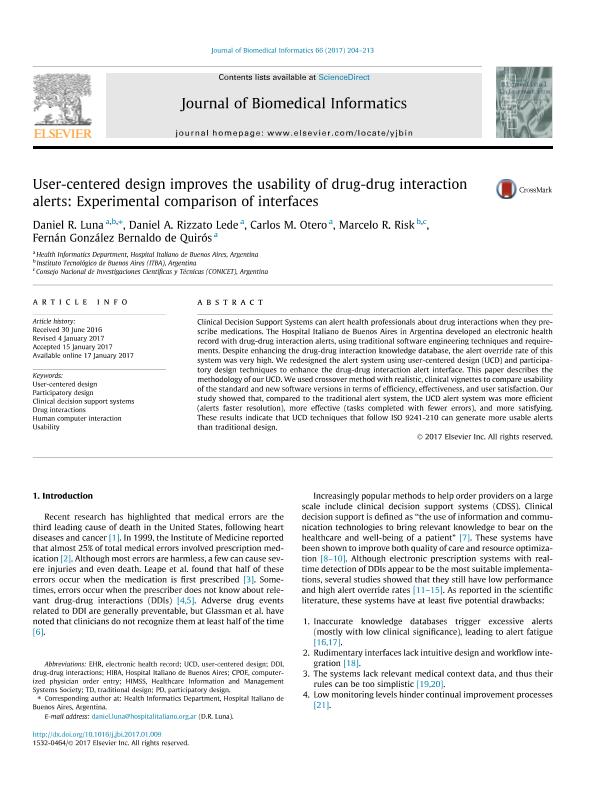Artículo
User-centered design improves the usability of drug-drug interaction alerts: Experimental comparison of interfaces
Luna, Daniel Roberto; Rizzato Lede, Daniel A.; Otero, Carlos Martin; Risk, Marcelo ; González Bernaldo de Quirós, Fernán
; González Bernaldo de Quirós, Fernán
 ; González Bernaldo de Quirós, Fernán
; González Bernaldo de Quirós, Fernán
Fecha de publicación:
02/2017
Editorial:
Academic Press Inc Elsevier Science
Revista:
Journal Of Biomedical Informatics
ISSN:
1532-0464
Idioma:
Inglés
Tipo de recurso:
Artículo publicado
Clasificación temática:
Resumen
Clinical Decision Support Systems can alert health professionals about drug interactions when they prescribe medications. The Hospital Italiano de Buenos Aires in Argentina developed an electronic health record with drug-drug interaction alerts, using traditional software engineering techniques and requirements. Despite enhancing the drug-drug interaction knowledge database, the alert override rate of this system was very high. We redesigned the alert system using user-centered design (UCD) and participatory design techniques to enhance the drug-drug interaction alert interface. This paper describes the methodology of our UCD. We used crossover method with realistic, clinical vignettes to compare usability of the standard and new software versions in terms of efficiency, effectiveness, and user satisfaction. Our study showed that, compared to the traditional alert system, the UCD alert system was more efficient (alerts faster resolution), more effective (tasks completed with fewer errors), and more satisfying. These results indicate that UCD techniques that follow ISO 9241-210 can generate more usable alerts than traditional design.
Archivos asociados
Licencia
Identificadores
Colecciones
Articulos(SEDE CENTRAL)
Articulos de SEDE CENTRAL
Articulos de SEDE CENTRAL
Citación
Luna, Daniel Roberto; Rizzato Lede, Daniel A.; Otero, Carlos Martin; Risk, Marcelo; González Bernaldo de Quirós, Fernán; User-centered design improves the usability of drug-drug interaction alerts: Experimental comparison of interfaces; Academic Press Inc Elsevier Science; Journal Of Biomedical Informatics; 66; 2-2017; 204-213
Compartir
Altmétricas



